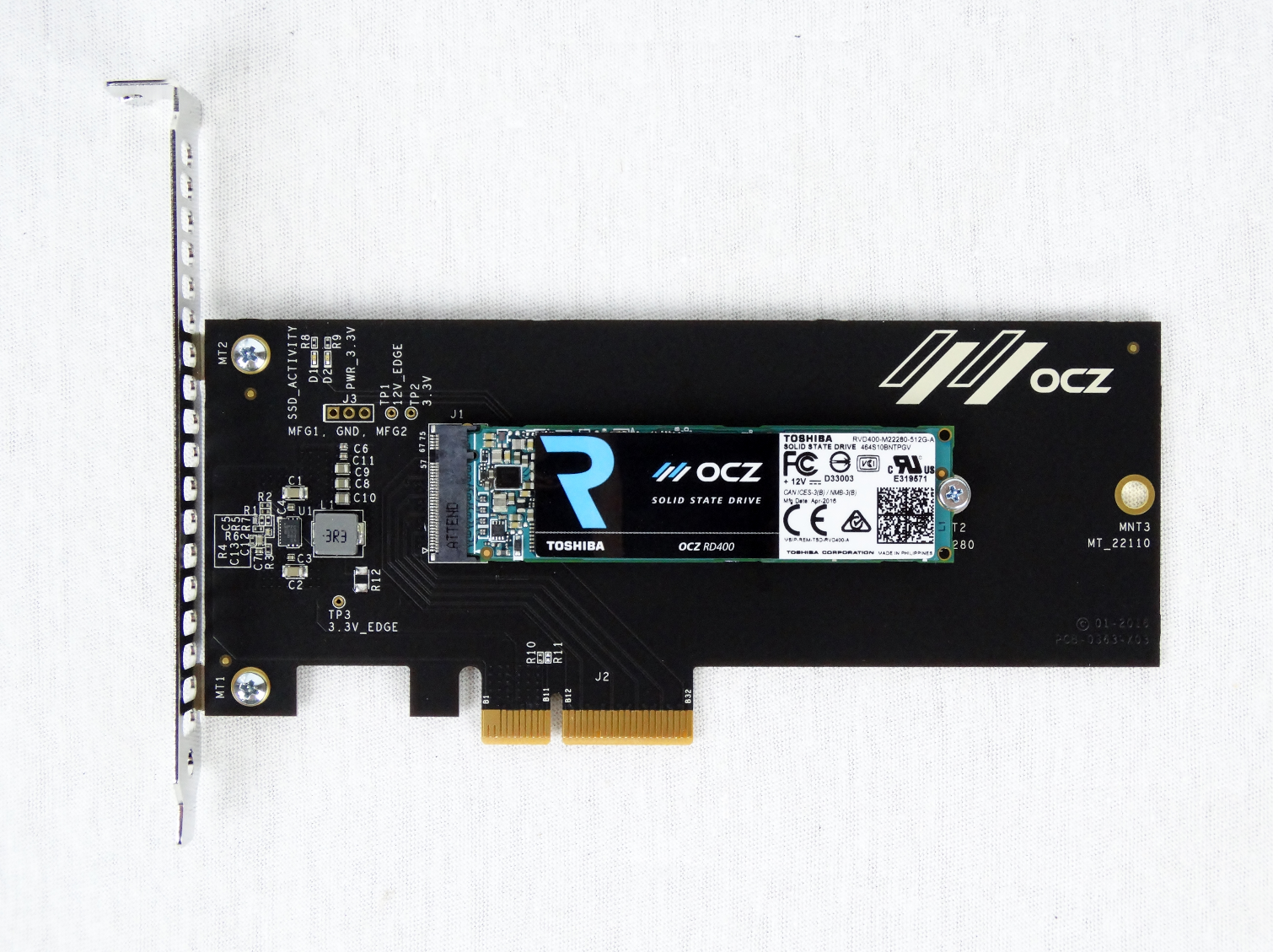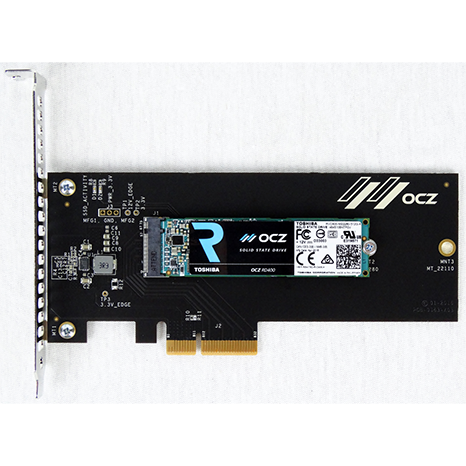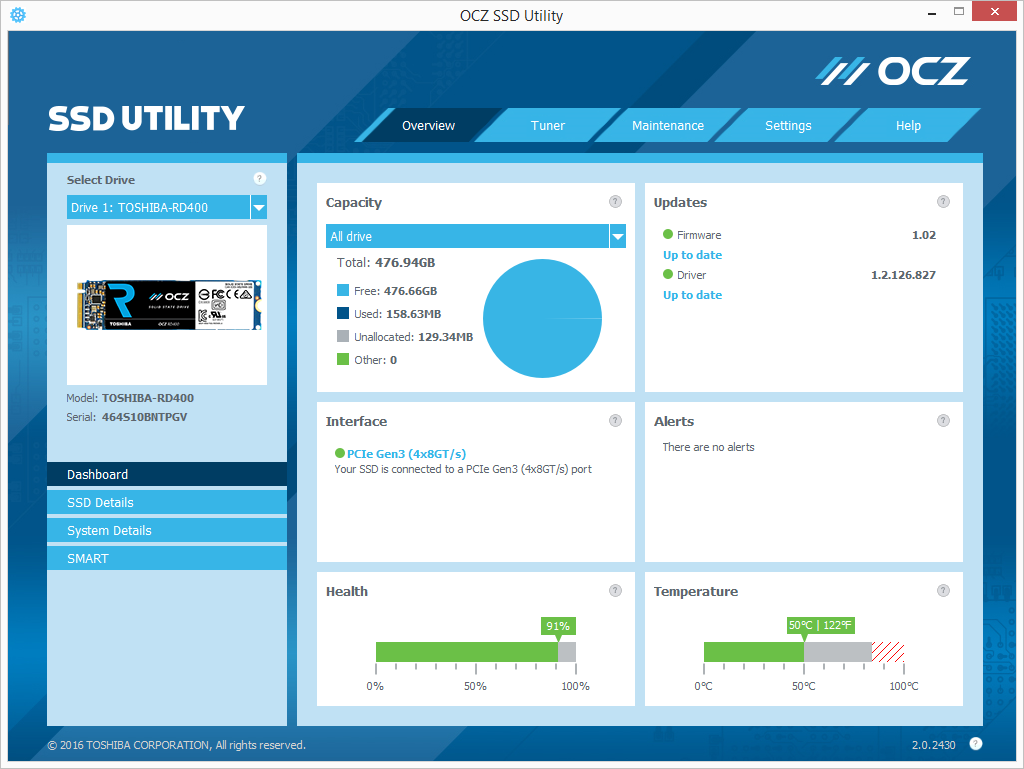Early Verdict
Without the advances of 3D NAND flash and the features that come with it (density and endurance), OCZ is limited by the tools it has. If released in early 2015 the RD400, is a remarkable product - but market conditions have changed. The number of high-performance SSD buyers has shrunk. Entry-level and mainstream SSDs are very good, and most importantly, they are cheap. The 950 Pro is a superior product but the RD400 is not far behind. OCZ can pick up the slack with aggressive pricing, but we will have to wait and see if Toshiba takes that road in the coming weeks.
Pros
- +
The RD400 doubles the capacity of the existing NVMe-based M.2 SSDs sold today in the retail market. The 1 TB capacity size is the standout product of this series, but it comes at a high price and we suspect it will only have this exclusive title for a short period of time. All of the RD400 drives we tested perform very well, but other factors push us back to the market-leading 950 Pro.
Cons
- -
We feel the RD400 has priced many OCZ fans out of the NVMe game. The market will determine the final selling price or these drives will sit in warehouses. The 1 TB offering is a nice product but the $700+ price only appeals to a small market. With that in mind, the RD400 is a true RevoDrive, but we expect NVMe SSDs from SMI and Phison will move NVMe to commodity pricing by the end of the year.
Why you can trust Tom's Hardware
Specifications, Pricing, Warranty And Accessories
OCZ has teased us with its NVMe M.2 prototype for a full year now; it first appeared at Computex in June of 2015 as the RevoDrive 400. In the interim, OCZ has displayed the drive at every turn, but Toshiba's influence has kept the product in development to ensure a successful launch, and hopefully strong sales.
We, and other sites, notice the proliferation of negativity about OCZ in the comments section of every OCZ news post or product review. Undoubtedly, even before reading beyond this point, some are already reaching for their keyboards to pen a chilling tale of a poor product, support or warranty issue.
In the past, OCZ would flaunt a prototype fresh off the production line at a trade show and we would see retail products within a few months. Times have changed and OCZ is now part of Toshiba, which is renowned for its extensive testing, longer development cycles and true tier 1 status, which should have numerous positive impacts. It means the days of OCZ playing fast and loose with its products are over.
Now the underlying technology, testing and general business of manufacturing SSDs belongs to Toshiba, while OCZ, a shell of its former self, does what it has always done best: marketing.
The days of OCZ being first to market with new technology are likely over. Toshiba has a strong focus on enterprise and OEM products, so the company knows how to develop and debug SSDs to ensure a positive user experience from start to finish, but it is rarely first to market with new technology.
The new workflow appears to begin with a Toshiba SSD that is tested and validated for OEM customers. OCZ then tunes the OEM product for higher performance, and after additional testing the retail product comes out the other end. The process will slow OCZ's aggressive style, but at the same time it will remove the negative aspects of OCZ's previous business model.
Historically, the RevoDrive products have been OCZ's workstation product for professional users with a need for very high performance in sequential workloads. OCZ paired commodity SATA technology with entry-level RAID controllers and TRIM support to achieve high performance. Many of the advantages of the RevoDrive were lost when Intel brought TRIM to RAID arrays by incorporating it into the PCH chipset. The magic sauce was in nearly every enthusiast and mainstream motherboard.
Get Tom's Hardware's best news and in-depth reviews, straight to your inbox.
I am not sure how I feel about OCZ branding a single M.2 SSD as a RevoDrive product. The new RD400 is faster than any previous RevoDrive SSD, but it limits and even downplays the product line. Several companies, including a company named Liqid, are working on M.2 NVMe-based RAID products. Seagate announced a similar product that delivers up to 10 GB/s of performance, and Dell, HP, and Kingston also have NVMe RAID products either in development or shipping to customers. The RD400 we are looking at today is the first consumer-focused RevoDrive SSD, but don't get me wrong, the performance is prosumer grade.
Specifications
MORE: Best SSDs For The MoneyMORE: Latest Storage News
MORE: Storage in the Forums
The new OCZ RD400 ships in four capacity sizes that range from 128 to 1024GB (1TB). The SSD ships with or without an add-in card (AIC) adapter and the largest capacity model is special in a few ways. It is the first 1TB M.2 NVMe SSD for the retail consumer market, and it is also the first affordable 1TB-class NVMe SSD. Affordability has a different meaning for everyone, but the RD400 is $400 less than Intel's 1.2TB SSD 750, which is a good place to start.
The OCZ RD400 competes well against the Samsung 950 Pro and Intel SSD 750 products. On paper, all three products dice the specifications with each outshining the other in one of the four-corner workloads for separate capacity sizes.
NVMe changes the way companies test products, but the new methods do not mimic common consumer storage workloads. On-paper performance is not worth much until the industry develops operating systems and software applications that take advantage of the advanced queuing features enabled by the NVMe protocol. Because of that, we will not comment on spec-sheet performance, and instead will show how the drives perform later in the review.
The RD400 architecture is identical to the Toshiba XG3 OEM-focused SSD we purchased earlier in the year. At the heart of the RD400 is a Toshiba TC58NCP 8-channel controller paired with Toshiba 15nm multi-level cell (MLC) NAND flash. We have seen both Samsung and Elpida LPDDR3 DRAM on these drives, but both memory packages run at 1600 MHz.
The RD400 is faster than the XG3 products we have tested, and some of the performance and throttling characteristics lead us to believe that the RD400 features a higher controller clock speed. We asked OCZ about the clock speed, and it replied that the RD400 uses the same clock and thermal throttle settings as the XG3.
OCZ tuned the firmware for higher performance and included an in-house NVMe driver that boosts performance over the Microsoft Windows default driver. Toshiba does not provide a driver with the XG3, but it allows OEMs to build a custom NVMe driver or utilize the Microsoft driver.
Pricing, Warranty And Accessories
| MSRP List | RD400 128GB | RD400 256GB | RD400 512GB | RD400 1TB |
|---|---|---|---|---|
| M.2 | $109.99 | $169.99 | $309.99 | $739.99 |
| Add-In Card | $129.99 | $189.99 | $329.99 | $759.99 |
OCZ is not as aggressive with pricing as we expected, but the 256GB and 512GB drives list for less than Samsung's 950 Pro NVMe SSDs with comparable capacity (SSD-only configuration). The RD400 models that include an OCZ-branded M.2 to PCIe 3.0 x4 adapter increase the cost of each drive by $20. You can find M.2 to PCIe adapters at online retailers close to this price point, but to increase compatibility with other systems we recommend purchasing the drive with the adapter card.
The RD400 has 5 years of warranty coverage, but OCZ included a clause that limits the warranty based upon the amount of data written to the SSD (74TB for the 128GB model and 592TB for the 1TB model).
The RD400 can write a tremendous amount of data in a very short time; we bled through 10% of the available write endurance on the 480GB model during our testing. Users should consider endurance before running demanding benchmarks on the SSD. Benchmarks like the Futuremark PCMark 8 Advanced test and StorScore reach steady state before taking measurements, but within a few days, a user can write a lot of data and burn through the warranty.
The main accessory for the RD400 is the M.2 to PCIe adapter. OCZ has already built support for the RD400 into the SSD Utility software. The software works very well in Windows and has features that others claim to have (but gray out) in Windows 8 and 10, like secure erase.

Chris Ramseyer was a senior contributing editor for Tom's Hardware. He tested and reviewed consumer storage.
-
2Be_or_Not2Be I believe Toshiba should just kill the OCZ brand name. As the author mentions, a lot of people have bad reactions to OCZ products. For every user who had good memories, there are at least 3-4 others who don't. So make a clean break - kill the OCZ brand name & either create a new one or just use Toshiba.Reply -
CaedenV ReplyI believe Toshiba should just kill the OCZ brand name. As the author mentions, a lot of people have bad reactions to OCZ products. For every user who had good memories, there are at least 3-4 others who don't. So make a clean break - kill the OCZ brand name & either create a new one or just use Toshiba.
I mean... have you ever used a Toshiba laptop? You think people have bad memories of OCZ! At least the OCZ issues only poisoned the cheap enthusiast market. Toshiba's own bad name is far more broad reaching. -
CaedenV My own expierence with OCZ was hit and miss. Their great products were fantastic and cheap, while their crap was really truly crap. 3-4 years ago when I was upgrading to SSDs I bought all OCZ products simple because there was nothing else that was affordable at the time. A lot of their gen2 products were pretty scarry, but their 3rd gen Agility lineup was pretty reliable, and came in much MUCH cheaper than anyone else. I had a Solid 2 and Agility 2 that died on me, which were replaced by an Agility 3 and Vertex 3 (both under warranty). So my expierence was not too terrible.Reply
But then again, you get what you pay for. Any time a new tech comes in that much cheaper than the competition you have to expect failures.
Not to mention, some of their PSUs were fantastic! After they bought PC Power & Cooling you could get essentially a PCnP PSU for $50 less as an OCZ rebrand! I have a 750W 80+Silver OCZ rebrand and it has been running 24/7 for almost 5 years without so much as a hiccup! Granted, their in-house OCZ PSUs were crap... but that's why you do a bit of research before buying. -
2Be_or_Not2Be ReplyI believe Toshiba should just kill the OCZ brand name. As the author mentions, a lot of people have bad reactions to OCZ products. For every user who had good memories, there are at least 3-4 others who don't. So make a clean break - kill the OCZ brand name & either create a new one or just use Toshiba.
I mean... have you ever used a Toshiba laptop? You think people have bad memories of OCZ! At least the OCZ issues only poisoned the cheap enthusiast market. Toshiba's own bad name is far more broad reaching.
So you're saying you would go for the new brand name option. ;)
Actually, I have used several Satellite Pro laptops back in the day; they weren't too bad. Even you really want to go back, I've used Toshiba FDDs (floppy disk drives) w/no problems. I also have a number of Toshiba enterprise drives, both HDD and SSD. So I guess for me, Toshiba has much better brand equity in my mind than OCZ. -
erendofe the only thing I bought of OCZ was a 2 power supplies (700W)... I guess its kinda hard to completely screw them up because both work great. must be luckyReply -
3ogdy "We, and other sites, notice the proliferation of negativity about OCZ in the comments section of every OCZ news post or product review. Undoubtedly, even before reading beyond this point, some are already reaching for their keyboards to pen a chilling tale of a poor product, support or warranty issue.Reply
In the past, OCZ would flaunt a prototype fresh off the production line at a trade show and we would see retail products within a few months. Times have changed and OCZ is now part of Toshiba, which is renowned for its extensive testing, longer development cycles and true tier 1 status."
I'm glad people like you are aware of this. I'm sad people like OCZ might not be. Well, after how successful they ended up being (/irony) they probably know it too.
How about making this cursed name disappear from the market? It just doesn't matter if Toshiba, Samsung, Microsoft, Bill Gates the man himself, God or an alien aliance bought OCZ. We all remember how they treated their customers and how disastrous their products were. I'm gonna stop talking about it here because you ALL know what's up with OCZ. Toshiba, be smart about it...get rid of that name.
It seems very strange that they decided to put their tech under that crappy brand's hood and market those when they already knew what the problem was. Buying one of those products was like buying a lottery ticket.
Dog gamn, even dictionaries from the Roman era had taken notice of this lousy company's products before they went downhil. I'm surprised there are no comments on how OCZ would destroy their own products through the release of updates that bricked their customers' drives for free? (do I see a pattern here? Oh...right, it's OCZ) l:
-
crenwelge I got great customer service out of OCZ, they promptly replaced an SSD for me that I mistakenly thought was bad. Turns out, the problem was with my Asrock hardware. Asrock is either the stupidest or most dishonest company I've ever dealt with. After 5 RMA's I finally gave up on Asrock. I diagnosed and paid for a replacement out of my own pocket.Reply -
Virtual_Singularity The listed numbers look promising for the RD400, no doubt. It may be worth noting that of the top 3 performers we see in the charts, only Samsung at least offers a basic level of data security via their AES 256-bit for User Data Encryption. I thought Intel's 750 series would surely at least include the same, and was a tad surprised to find out they don't.Reply -
LordConrad I have two Vertex 2 drives and one Vertex 3, and never had any problems with them.Reply
I prefer Samsung drives these days because of the V-NAND endurance but the RD400 is a good drive, I would buy one if the price was right.


